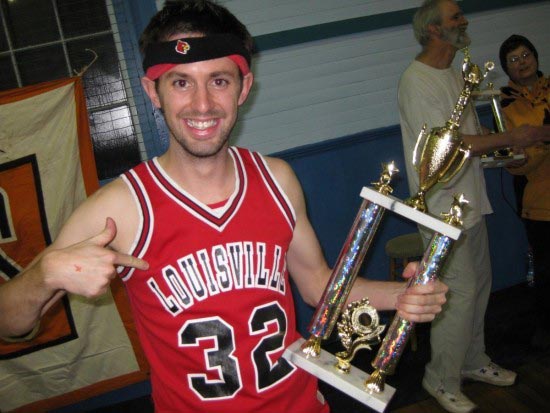Playground Smack-down
Chris Glasser wins 2009 four square world championship
The popularity of a sport is fickle. When he invented basketball in the 1890s, James Naismith based it loosely on a school-yard game called duck-on-a-rock, but over the last century it grew into a multi-billion dollar spectator sport.
Until recently, the humble game of four square has been relegated to middle school playgrounds, summer camps and after-school programs; it has been the exclusive purview of well-coordinated 12-year-olds provisioned with a ball, chalk and a patch of pavement. Then in 2004, Peter Lowell of the Lakes Environmental Association of Bridgeton, Maine, established the Four Square World Championships. This year, Chris Glasser (Col ’06) survived a series of elimination rounds to beat out more than 100 competitors and become the 2009 Men’s World Champion in four square.
In the final round, Glasser’s competition included six other men and an 11-year-old boy. “That kid was a sick player,” says Glasser. “At first, I thought I’d take it easy on him because he was a little kid, but then he’d give me a slicey hit with backspin on it. He was so close to ground, he’d hit the ball and I couldn’t touch it. He made me look foolish. Of course, the advantage we had over him was that we could slam the ball over his head. But when you do that in front of a crowd of 200 people, you feel like a jerk.”
“I totally dominated the court when I was a kid. Of course, I was good as a kid, that’s like saying that Michael Jordan was pretty good at basketball when he was a kid. Well, duh. Of course he was good, he was playing against a bunch of kids. At recess, four square was my one chance to be a bully. So I took it.”
The final round involved 30 minutes of play at the end of which whoever hit the most balls from the king position was the winner. This year, at the 30-minute mark, there was a tie between two players, so the game went into overtime. “We played for five or 10 more minutes, and I did well during the overtime,” says Glasser. “I don’t actually know if I was one of the two who was tied at the half hour mark or not, but by the end I had a one point lead and the title was mine.” Glasser says his strategy was to play poorly early on. “People stopped focusing on me as someone who they needed to knock out. Four square is a game where if the mob is against you, you lose; but in this case, they forgot about me, which helped.”
Glasser, who works as an editorial assistant for a summer enrichment program called Exploration and studies computer science at Harvard, keeps his trophy in his den. “It’s the one piece of decoration in my TV room,” he says.

When asked why he would pursue a sport like four square, Glasser is circumspect: “Why? Because it’s silly.”
“I’ve done a lot of theorizing about the proper way to play,” says Glasser. “You need to challenge your competitor, but you also have to cooperate with them. You can hit the ball in a way that they can’t touch it, but really that’s no fun for anyone. If you give it 75 percent of your effort then your opponent will have to lunge for it, but they can return it. It’s like a dance.”
Basic Rules of Four Square
Four square is played with a rubber playground ball on a square court with four players. When the ball is bounced into your square you must then bounce it back out without hitting twice in your own square, otherwise you are out. The object is to eliminate players in higher squares so that you can make it to the “four square” or “king square” and score the most points.